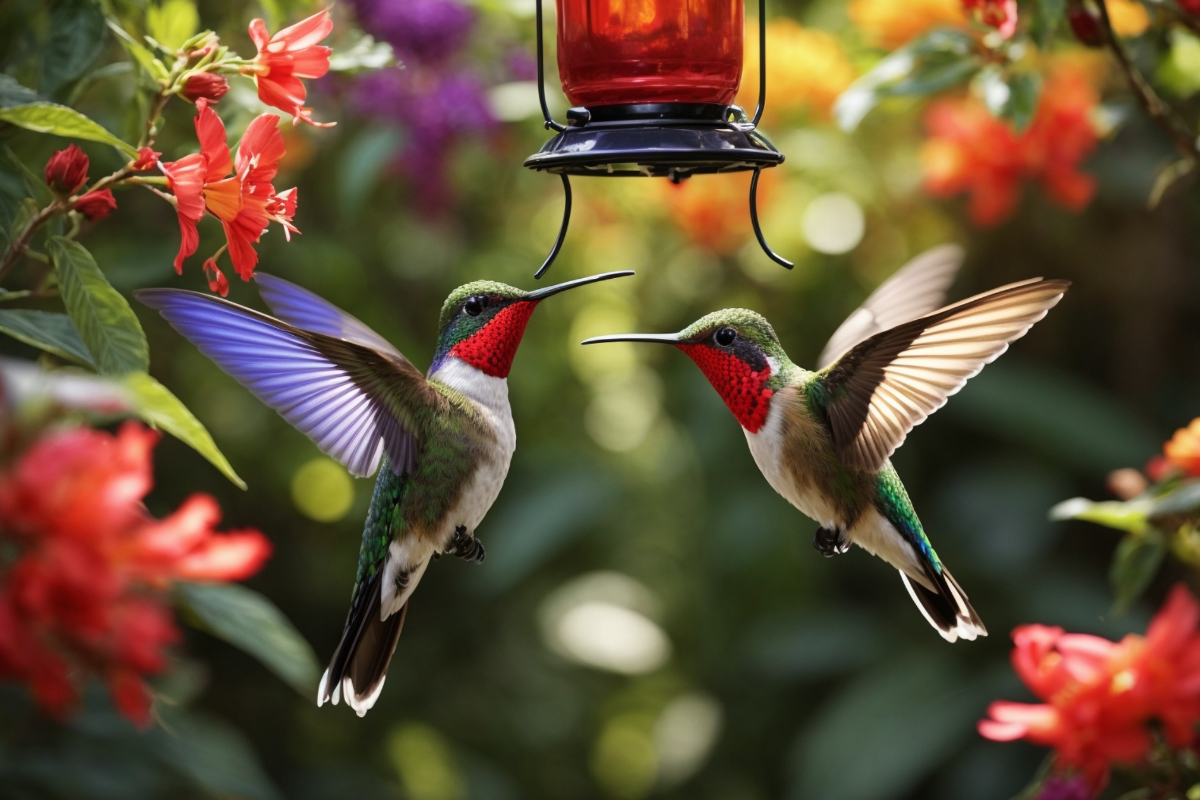Hummingbirds are fascinating creatures known for their territorial behavior, especially during feeding. They fiercely defend resources like food sources and nesting sites. This behavior is more pronounced in males, particularly during the breeding season when they compete to attract mates by defending areas rich in nectar. Females also exhibit territoriality, especially when safeguarding their nests. They chase away other hummingbirds, perform aggressive aerial displays, and vocalize to protect their territory.
Understanding this aspect of hummingbird behavior can enhance bird-watching experiences. It is interesting to note that some species, such as the Ruby-throated and Rufous hummingbirds, are known to be the most territorial birds.
Hummingbirds exhibit territorial behavior to ensure access to essential resources such as food and nesting sites. Male hummingbirds are particularly territorial during the breeding season as they compete to attract mates by defending areas rich in nectar. Females also show territoriality, especially when safeguarding their nests. This behavior is vital for their survival and varies among species and individuals in intensity and frequency.
The territorial nature of hummingbirds is particularly pronounced during specific times and conditions, with the peak of their territoriality aligning with the breeding season. Male hummingbirds aggressively defend areas rich in nectar to attract potential mates. This behavior is crucial for mating success and is often accompanied by dazzling aerial displays and vocal confrontations.
Outside the breeding season, their territorial behavior can still be observed but is usually less intense. It is primarily driven by the need to secure reliable food sources. Hummingbirds fiercely guard feeders or flower patches, ensuring a steady supply of nectar to maintain their high metabolism.
Observing and respecting their space is crucial for birdwatchers and nature enthusiasts. Overcrowding can lead to excessive territorial disputes among hummingbirds. To minimize conflicts, it is recommended to spread out feeders, plant diverse flowers to cater to more hummingbirds, and observe their interactions from a distance.
Female hummingbirds can also be territorial, particularly when it comes to protecting their nesting sites. They actively defend the areas around their nests to ensure the safety of their eggs and chicks from potential threats and disturbances.
Hummingbirds are territorial over feeders as well. They view feeders as valuable food sources and vigorously defend them from other hummingbirds. This territorial behavior involves chasing away intruders and sometimes engaging in aerial displays to establish dominance over the feeder area. While both males and females can show this territorial behavior, it is more commonly observed in males, especially during the breeding season when competition for resources is high.
Hummingbirds exhibit territorial behavior over nectar flowers too. They guard areas rich in nectar-producing flowers to maintain exclusive feeding rights. This territoriality ensures a steady nectar supply, which is crucial for their high-energy lifestyle. Their defense tactics include aggressive chases and aerial displays to deter other hummingbirds from accessing these flowers. This behavior is particularly evident during peak feeding times and breeding seasons.
Hummingbirds are generally not territorial towards humans. Their territorial behavior is typically directed at other hummingbirds or small animals that they perceive as threats to their food sources or nests. While they may display curiosity or boldness around humans, especially in areas where they are accustomed to human presence, hummingbirds do not exhibit the same aggressive territorial behaviors towards people as they do towards other birds.
Hummingbirds can exhibit aggressive behavior towards other bird species, particularly when defending their feeding territories. They chase and confront larger birds that enter areas with food sources like nectar feeders or flower gardens. This assertive behavior is a protective mechanism to maintain access to vital food resources and is not indicative of general hostility towards other birds. The intensity of this behavior varies among individual hummingbirds and is influenced by factors such as the availability of food and the breeding season.
Hummingbirds protect themselves using several strategies. Their small size and agility in flight allow them to quickly escape predators. They also use their rapid wingbeats to create a humming sound that can deter some predators. Additionally, they exhibit territorial behavior, aggressively defending their feeding areas and nests from intruders, including other birds and small animals. Their sharp beaks and fast maneuvers are effective tools in these confrontations. They often choose nesting sites that are hidden or difficult to access, adding another layer of protection for their young.
To prevent hummingbirds from fighting over feeders, it is recommended to place multiple feeders out of sight from each other, space the feeders throughout the yard to create separate feeding zones, introduce a variety of nectar plants in the garden, keep feeders clean and filled with fresh nectar, and monitor the hummingbirds’ behavior to adjust feeder placement as needed.
Hummingbirds are territorial creatures driven by the need to secure essential resources like food and nesting sites. Their territorial behavior is a testament to their survival instincts and is a fascinating aspect of their natural history. By understanding and respecting their territorial nature, we can coexist with these beautiful birds and appreciate their presence in our gardens and natural spaces.
